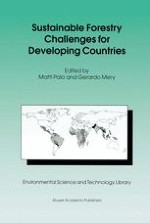1996 | OriginalPaper | Buchkapitel
Man and Forest in African History
verfasst von : Ari Siiriäinen
Erschienen in: Sustainable Forestry Challenges for Developing Countries
Verlag: Springer Netherlands
Enthalten in: Professional Book Archive
Aktivieren Sie unsere intelligente Suche, um passende Fachinhalte oder Patente zu finden.
Wählen Sie Textabschnitte aus um mit Künstlicher Intelligenz passenden Patente zu finden. powered by
Markieren Sie Textabschnitte, um KI-gestützt weitere passende Inhalte zu finden. powered by
Man has extracted raw material and energy from woodlands and forests since the beginning of mankind, but the real manipulation of the environment began when man started to clear forests for cultivation and for cattle at least 4,000 years ago. Since then, man has spread to almost every ecotone, utilizing different methods of cultivation and grazing strategies. Population increases have forced societies to create new economical and technological innovations to increase production; migrations along different scales have also occurred. These activities have affected the environment through soil degradation, which in many marginal areas leads to desertification as a consequence. Deforestation has occurred especially in the restricted montane forest areas in East Africa, in the margins of the tropical forest zone, and in the sparse woodlands of south central Africa. In addition, the intensification of iron production contributed to the loss of trees. This development has been demonstrated by archaeological and palynogical investigations. In the article, a few case studies from various parts of tropical Africa are presented to show how natural long-term climatological and geological factors and human land use practices lead to a loss of trees and deforestation, soil erosion, and formation of wastelands.
